Business Finance Report: Financial Analysis and Cash Flow Management
VerifiedAdded on 2022/12/15
|12
|3302
|454
Report
AI Summary
This report analyzes two case studies related to business finance. The first part focuses on Trend Ltd, a gym clothing and footwear manufacturer, examining profit, cash flow, working capital components (receivables, inventory, payables), and the impact of working capital changes on cash flow. It analyzes the company's financial results, including investment decisions, debt, and disputes with customers and suppliers, and offers recommendations to improve cash flow through better working capital management. The second part involves Thorne Estates Limited, a real estate company, where a monthly cash budget from January to April 2021 is prepared. Based on the cash budget, the report provides observations and recommendations to the management of Thorne Estate Limited, considering factors like sales, fees charged, expenses, and loan payments. The report aims to provide a comprehensive understanding of financial analysis and cash flow management in business.
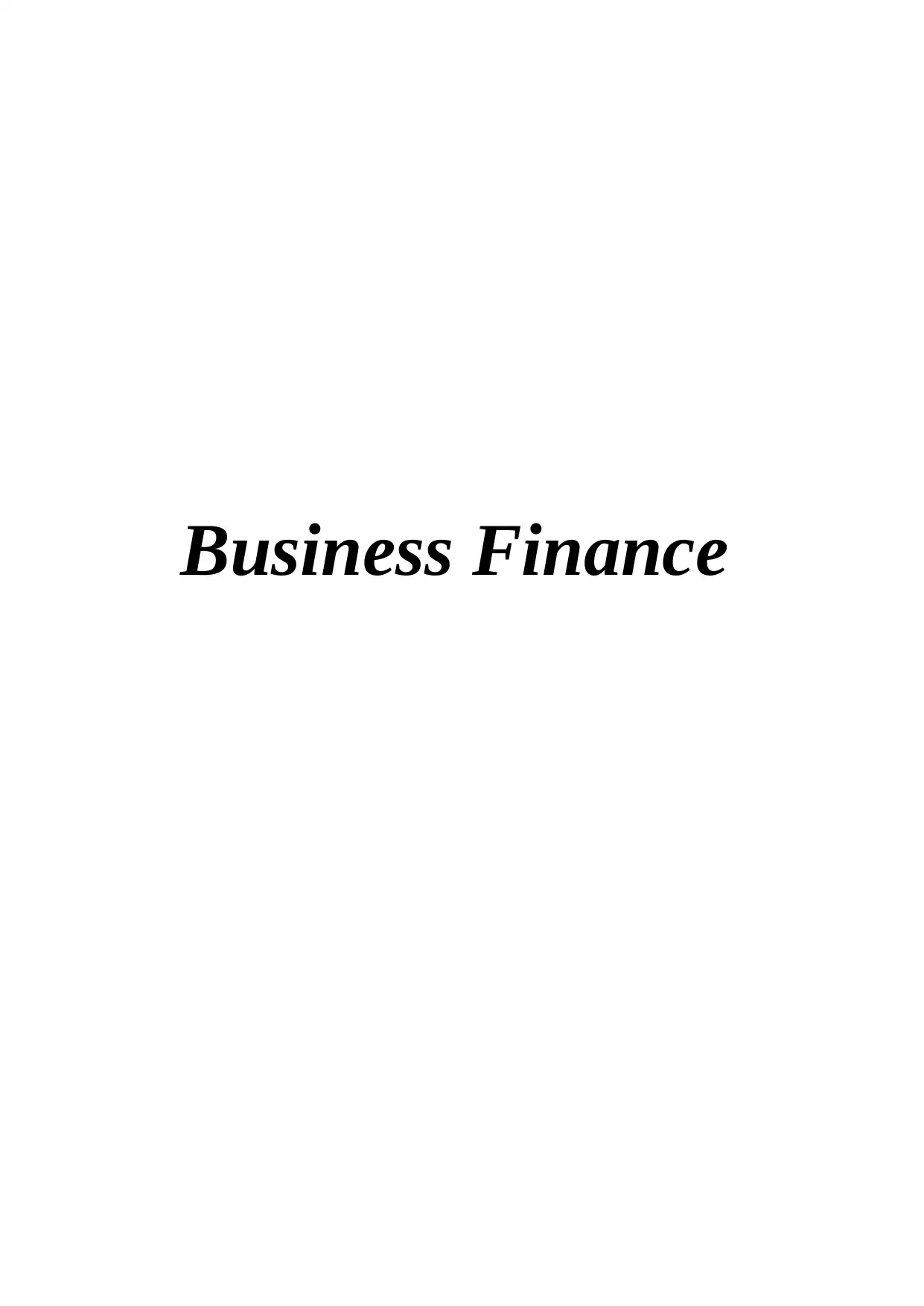
Business Finance
Paraphrase This Document
Need a fresh take? Get an instant paraphrase of this document with our AI Paraphraser
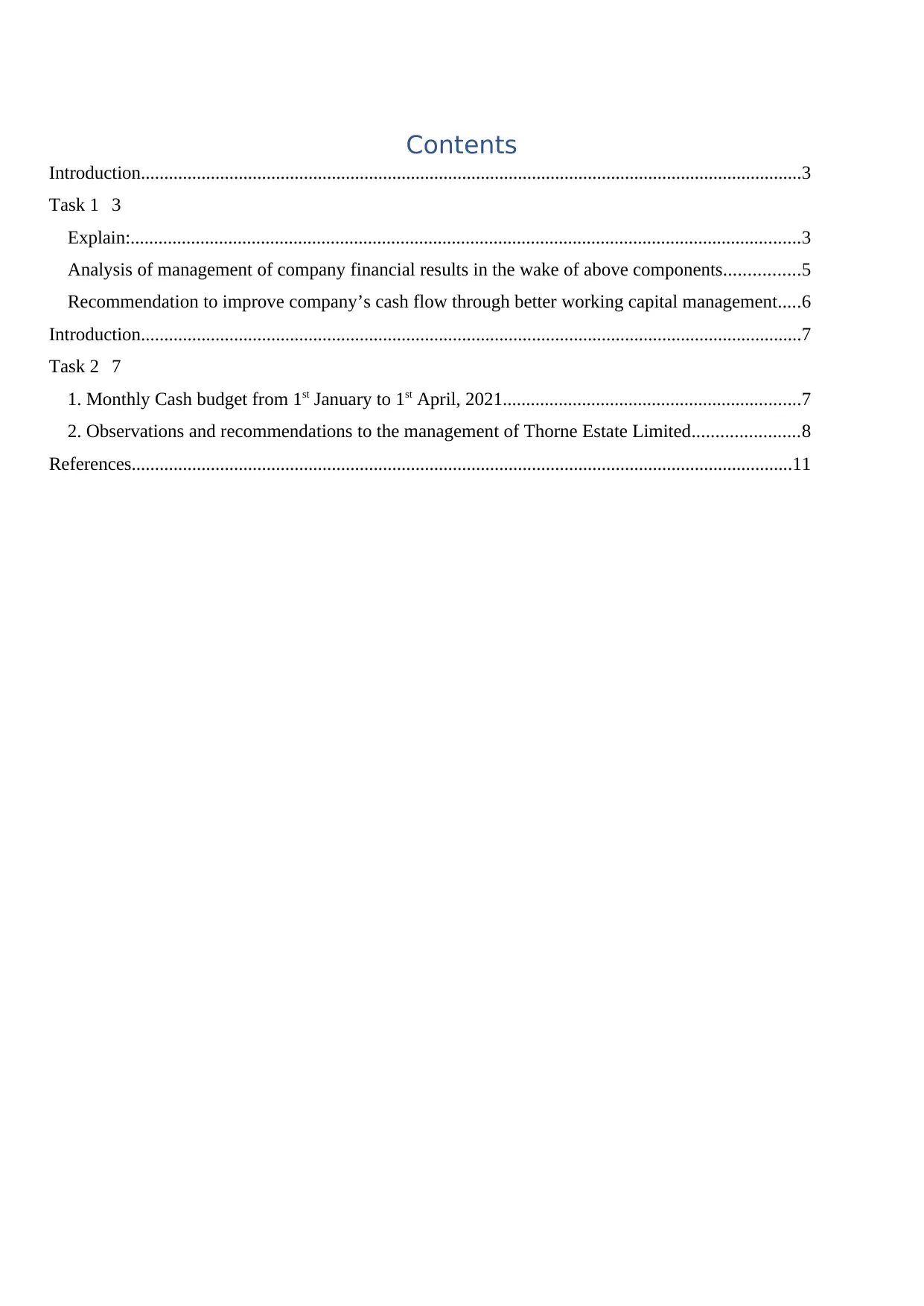
Contents
Introduction..............................................................................................................................................3
Task 1 3
Explain:................................................................................................................................................3
Analysis of management of company financial results in the wake of above components................5
Recommendation to improve company’s cash flow through better working capital management.....6
Introduction..............................................................................................................................................7
Task 2 7
1. Monthly Cash budget from 1st January to 1st April, 2021................................................................7
2. Observations and recommendations to the management of Thorne Estate Limited.......................8
References..............................................................................................................................................11
Introduction..............................................................................................................................................3
Task 1 3
Explain:................................................................................................................................................3
Analysis of management of company financial results in the wake of above components................5
Recommendation to improve company’s cash flow through better working capital management.....6
Introduction..............................................................................................................................................7
Task 2 7
1. Monthly Cash budget from 1st January to 1st April, 2021................................................................7
2. Observations and recommendations to the management of Thorne Estate Limited.......................8
References..............................................................................................................................................11
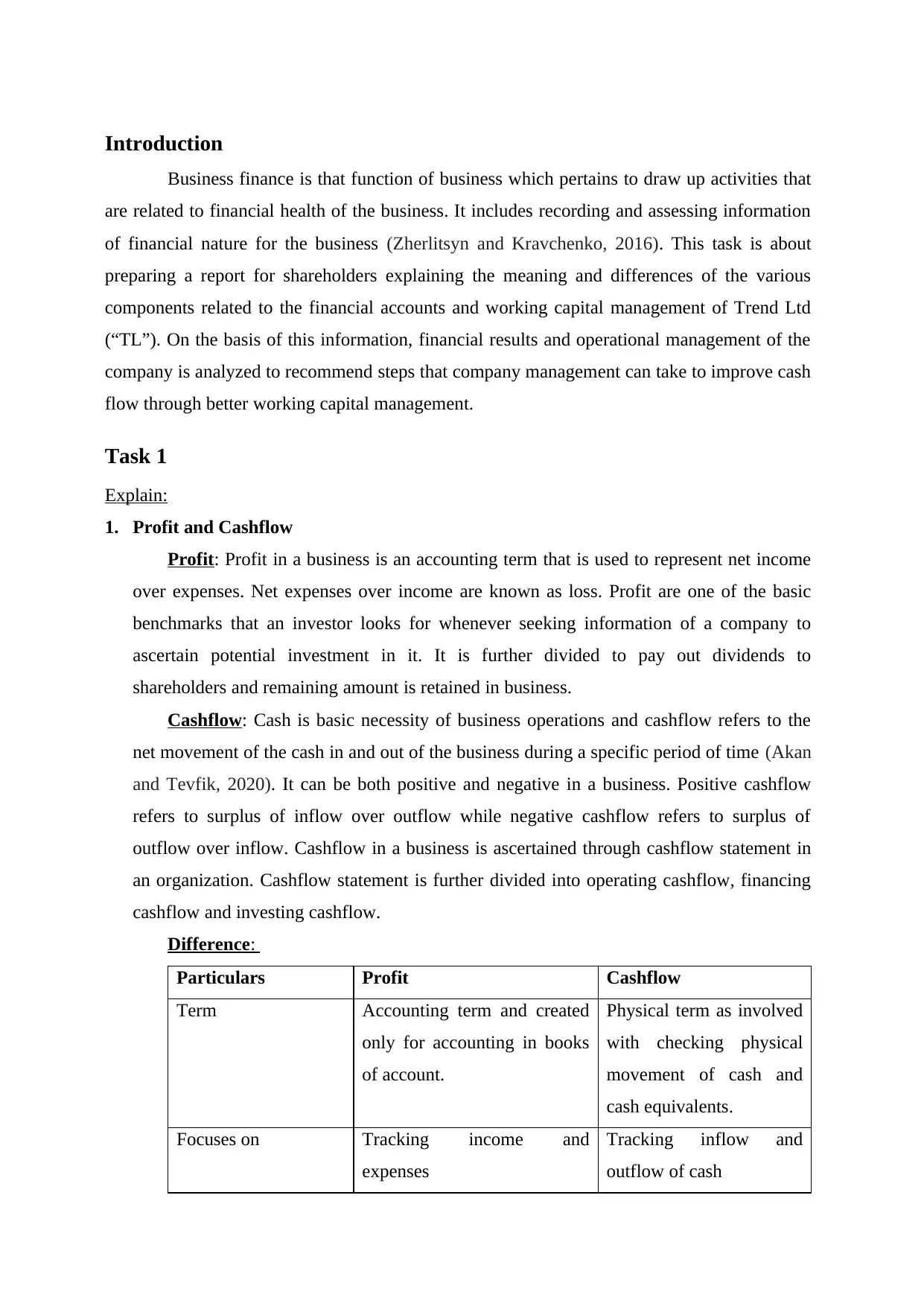
Introduction
Business finance is that function of business which pertains to draw up activities that
are related to financial health of the business. It includes recording and assessing information
of financial nature for the business (Zherlitsyn and Kravchenko, 2016). This task is about
preparing a report for shareholders explaining the meaning and differences of the various
components related to the financial accounts and working capital management of Trend Ltd
(“TL”). On the basis of this information, financial results and operational management of the
company is analyzed to recommend steps that company management can take to improve cash
flow through better working capital management.
Task 1
Explain:
1. Profit and Cashflow
Profit: Profit in a business is an accounting term that is used to represent net income
over expenses. Net expenses over income are known as loss. Profit are one of the basic
benchmarks that an investor looks for whenever seeking information of a company to
ascertain potential investment in it. It is further divided to pay out dividends to
shareholders and remaining amount is retained in business.
Cashflow: Cash is basic necessity of business operations and cashflow refers to the
net movement of the cash in and out of the business during a specific period of time (Akan
and Tevfik, 2020). It can be both positive and negative in a business. Positive cashflow
refers to surplus of inflow over outflow while negative cashflow refers to surplus of
outflow over inflow. Cashflow in a business is ascertained through cashflow statement in
an organization. Cashflow statement is further divided into operating cashflow, financing
cashflow and investing cashflow.
Difference:
Particulars Profit Cashflow
Term Accounting term and created
only for accounting in books
of account.
Physical term as involved
with checking physical
movement of cash and
cash equivalents.
Focuses on Tracking income and
expenses
Tracking inflow and
outflow of cash
Business finance is that function of business which pertains to draw up activities that
are related to financial health of the business. It includes recording and assessing information
of financial nature for the business (Zherlitsyn and Kravchenko, 2016). This task is about
preparing a report for shareholders explaining the meaning and differences of the various
components related to the financial accounts and working capital management of Trend Ltd
(“TL”). On the basis of this information, financial results and operational management of the
company is analyzed to recommend steps that company management can take to improve cash
flow through better working capital management.
Task 1
Explain:
1. Profit and Cashflow
Profit: Profit in a business is an accounting term that is used to represent net income
over expenses. Net expenses over income are known as loss. Profit are one of the basic
benchmarks that an investor looks for whenever seeking information of a company to
ascertain potential investment in it. It is further divided to pay out dividends to
shareholders and remaining amount is retained in business.
Cashflow: Cash is basic necessity of business operations and cashflow refers to the
net movement of the cash in and out of the business during a specific period of time (Akan
and Tevfik, 2020). It can be both positive and negative in a business. Positive cashflow
refers to surplus of inflow over outflow while negative cashflow refers to surplus of
outflow over inflow. Cashflow in a business is ascertained through cashflow statement in
an organization. Cashflow statement is further divided into operating cashflow, financing
cashflow and investing cashflow.
Difference:
Particulars Profit Cashflow
Term Accounting term and created
only for accounting in books
of account.
Physical term as involved
with checking physical
movement of cash and
cash equivalents.
Focuses on Tracking income and
expenses
Tracking inflow and
outflow of cash
⊘ This is a preview!⊘
Do you want full access?
Subscribe today to unlock all pages.

Trusted by 1+ million students worldwide
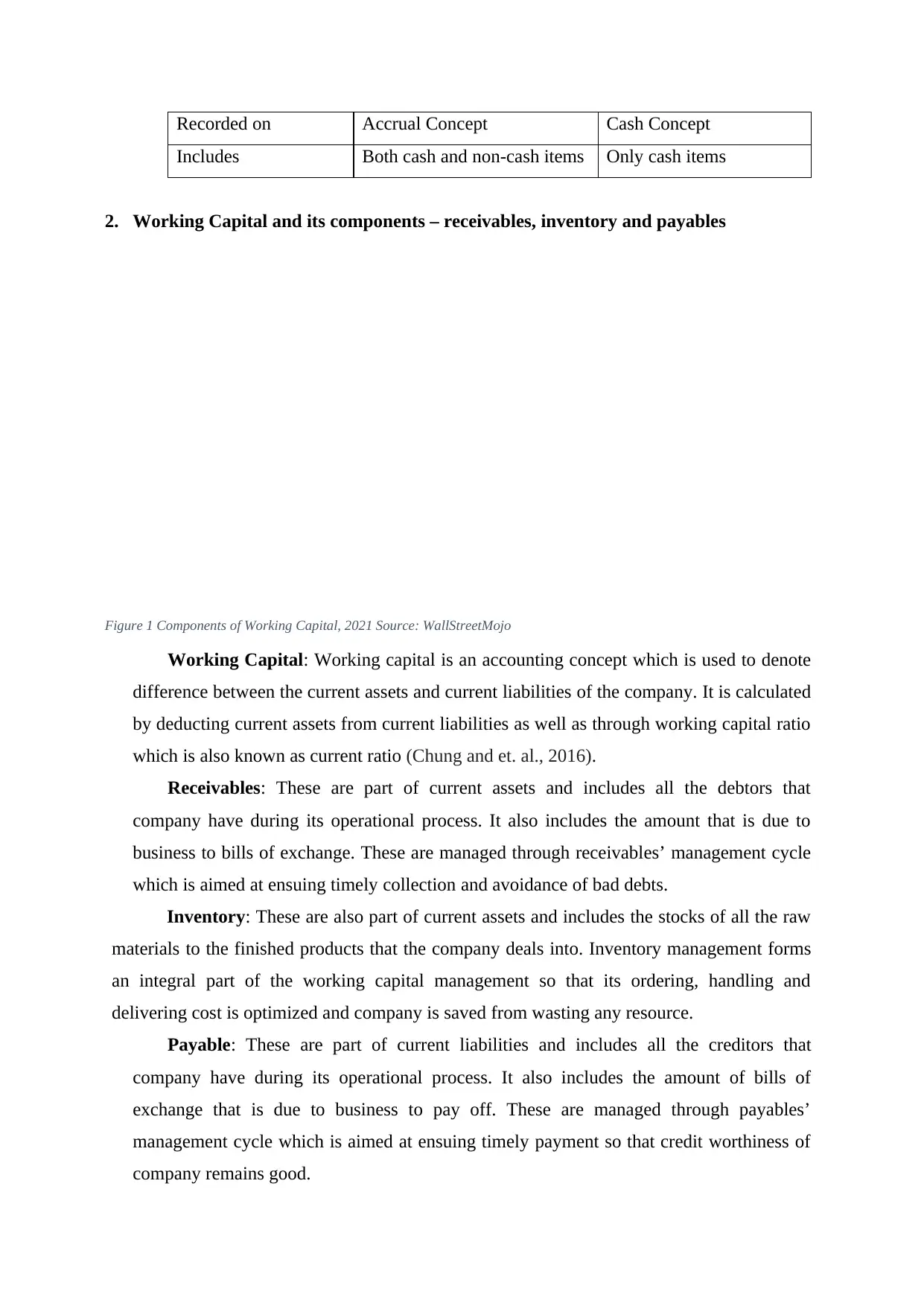
Recorded on Accrual Concept Cash Concept
Includes Both cash and non-cash items Only cash items
2. Working Capital and its components – receivables, inventory and payables
Figure 1 Components of Working Capital, 2021 Source: WallStreetMojo
Working Capital: Working capital is an accounting concept which is used to denote
difference between the current assets and current liabilities of the company. It is calculated
by deducting current assets from current liabilities as well as through working capital ratio
which is also known as current ratio (Chung and et. al., 2016).
Receivables: These are part of current assets and includes all the debtors that
company have during its operational process. It also includes the amount that is due to
business to bills of exchange. These are managed through receivables’ management cycle
which is aimed at ensuing timely collection and avoidance of bad debts.
Inventory: These are also part of current assets and includes the stocks of all the raw
materials to the finished products that the company deals into. Inventory management forms
an integral part of the working capital management so that its ordering, handling and
delivering cost is optimized and company is saved from wasting any resource.
Payable: These are part of current liabilities and includes all the creditors that
company have during its operational process. It also includes the amount of bills of
exchange that is due to business to pay off. These are managed through payables’
management cycle which is aimed at ensuing timely payment so that credit worthiness of
company remains good.
Includes Both cash and non-cash items Only cash items
2. Working Capital and its components – receivables, inventory and payables
Figure 1 Components of Working Capital, 2021 Source: WallStreetMojo
Working Capital: Working capital is an accounting concept which is used to denote
difference between the current assets and current liabilities of the company. It is calculated
by deducting current assets from current liabilities as well as through working capital ratio
which is also known as current ratio (Chung and et. al., 2016).
Receivables: These are part of current assets and includes all the debtors that
company have during its operational process. It also includes the amount that is due to
business to bills of exchange. These are managed through receivables’ management cycle
which is aimed at ensuing timely collection and avoidance of bad debts.
Inventory: These are also part of current assets and includes the stocks of all the raw
materials to the finished products that the company deals into. Inventory management forms
an integral part of the working capital management so that its ordering, handling and
delivering cost is optimized and company is saved from wasting any resource.
Payable: These are part of current liabilities and includes all the creditors that
company have during its operational process. It also includes the amount of bills of
exchange that is due to business to pay off. These are managed through payables’
management cycle which is aimed at ensuing timely payment so that credit worthiness of
company remains good.
Paraphrase This Document
Need a fresh take? Get an instant paraphrase of this document with our AI Paraphraser
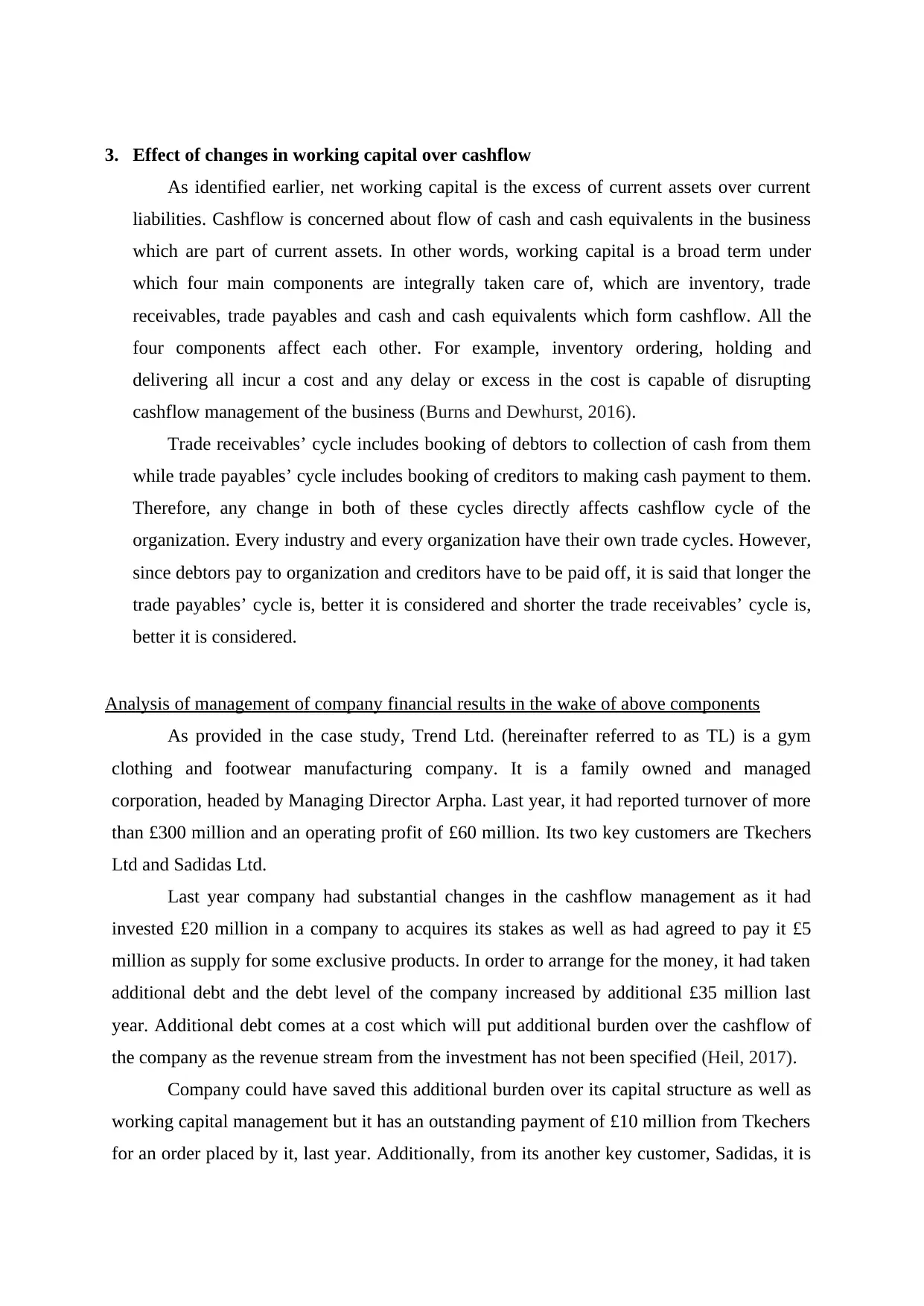
3. Effect of changes in working capital over cashflow
As identified earlier, net working capital is the excess of current assets over current
liabilities. Cashflow is concerned about flow of cash and cash equivalents in the business
which are part of current assets. In other words, working capital is a broad term under
which four main components are integrally taken care of, which are inventory, trade
receivables, trade payables and cash and cash equivalents which form cashflow. All the
four components affect each other. For example, inventory ordering, holding and
delivering all incur a cost and any delay or excess in the cost is capable of disrupting
cashflow management of the business (Burns and Dewhurst, 2016).
Trade receivables’ cycle includes booking of debtors to collection of cash from them
while trade payables’ cycle includes booking of creditors to making cash payment to them.
Therefore, any change in both of these cycles directly affects cashflow cycle of the
organization. Every industry and every organization have their own trade cycles. However,
since debtors pay to organization and creditors have to be paid off, it is said that longer the
trade payables’ cycle is, better it is considered and shorter the trade receivables’ cycle is,
better it is considered.
Analysis of management of company financial results in the wake of above components
As provided in the case study, Trend Ltd. (hereinafter referred to as TL) is a gym
clothing and footwear manufacturing company. It is a family owned and managed
corporation, headed by Managing Director Arpha. Last year, it had reported turnover of more
than £300 million and an operating profit of £60 million. Its two key customers are Tkechers
Ltd and Sadidas Ltd.
Last year company had substantial changes in the cashflow management as it had
invested £20 million in a company to acquires its stakes as well as had agreed to pay it £5
million as supply for some exclusive products. In order to arrange for the money, it had taken
additional debt and the debt level of the company increased by additional £35 million last
year. Additional debt comes at a cost which will put additional burden over the cashflow of
the company as the revenue stream from the investment has not been specified (Heil, 2017).
Company could have saved this additional burden over its capital structure as well as
working capital management but it has an outstanding payment of £10 million from Tkechers
for an order placed by it, last year. Additionally, from its another key customer, Sadidas, it is
As identified earlier, net working capital is the excess of current assets over current
liabilities. Cashflow is concerned about flow of cash and cash equivalents in the business
which are part of current assets. In other words, working capital is a broad term under
which four main components are integrally taken care of, which are inventory, trade
receivables, trade payables and cash and cash equivalents which form cashflow. All the
four components affect each other. For example, inventory ordering, holding and
delivering all incur a cost and any delay or excess in the cost is capable of disrupting
cashflow management of the business (Burns and Dewhurst, 2016).
Trade receivables’ cycle includes booking of debtors to collection of cash from them
while trade payables’ cycle includes booking of creditors to making cash payment to them.
Therefore, any change in both of these cycles directly affects cashflow cycle of the
organization. Every industry and every organization have their own trade cycles. However,
since debtors pay to organization and creditors have to be paid off, it is said that longer the
trade payables’ cycle is, better it is considered and shorter the trade receivables’ cycle is,
better it is considered.
Analysis of management of company financial results in the wake of above components
As provided in the case study, Trend Ltd. (hereinafter referred to as TL) is a gym
clothing and footwear manufacturing company. It is a family owned and managed
corporation, headed by Managing Director Arpha. Last year, it had reported turnover of more
than £300 million and an operating profit of £60 million. Its two key customers are Tkechers
Ltd and Sadidas Ltd.
Last year company had substantial changes in the cashflow management as it had
invested £20 million in a company to acquires its stakes as well as had agreed to pay it £5
million as supply for some exclusive products. In order to arrange for the money, it had taken
additional debt and the debt level of the company increased by additional £35 million last
year. Additional debt comes at a cost which will put additional burden over the cashflow of
the company as the revenue stream from the investment has not been specified (Heil, 2017).
Company could have saved this additional burden over its capital structure as well as
working capital management but it has an outstanding payment of £10 million from Tkechers
for an order placed by it, last year. Additionally, from its another key customer, Sadidas, it is
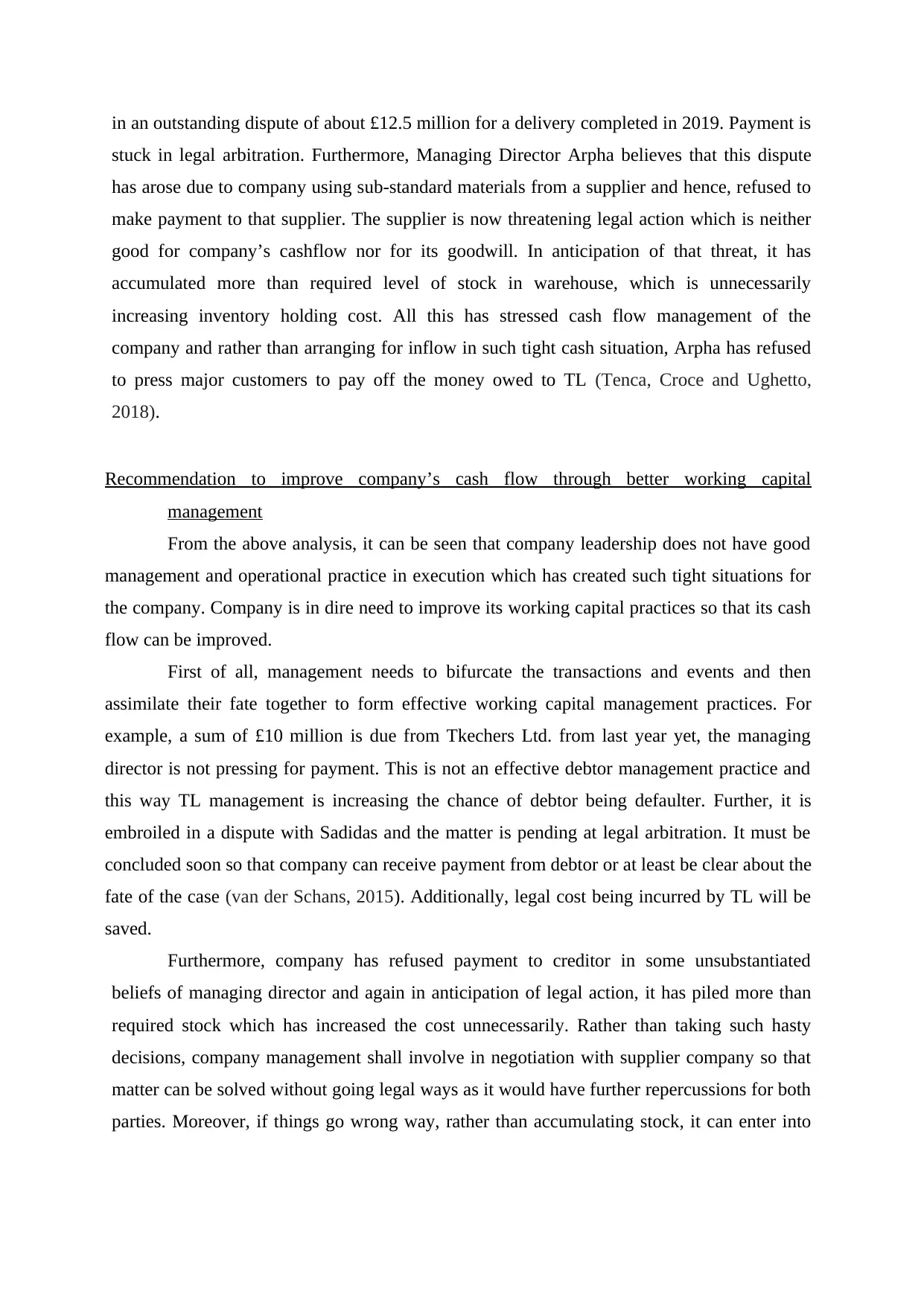
in an outstanding dispute of about £12.5 million for a delivery completed in 2019. Payment is
stuck in legal arbitration. Furthermore, Managing Director Arpha believes that this dispute
has arose due to company using sub-standard materials from a supplier and hence, refused to
make payment to that supplier. The supplier is now threatening legal action which is neither
good for company’s cashflow nor for its goodwill. In anticipation of that threat, it has
accumulated more than required level of stock in warehouse, which is unnecessarily
increasing inventory holding cost. All this has stressed cash flow management of the
company and rather than arranging for inflow in such tight cash situation, Arpha has refused
to press major customers to pay off the money owed to TL (Tenca, Croce and Ughetto,
2018).
Recommendation to improve company’s cash flow through better working capital
management
From the above analysis, it can be seen that company leadership does not have good
management and operational practice in execution which has created such tight situations for
the company. Company is in dire need to improve its working capital practices so that its cash
flow can be improved.
First of all, management needs to bifurcate the transactions and events and then
assimilate their fate together to form effective working capital management practices. For
example, a sum of £10 million is due from Tkechers Ltd. from last year yet, the managing
director is not pressing for payment. This is not an effective debtor management practice and
this way TL management is increasing the chance of debtor being defaulter. Further, it is
embroiled in a dispute with Sadidas and the matter is pending at legal arbitration. It must be
concluded soon so that company can receive payment from debtor or at least be clear about the
fate of the case (van der Schans, 2015). Additionally, legal cost being incurred by TL will be
saved.
Furthermore, company has refused payment to creditor in some unsubstantiated
beliefs of managing director and again in anticipation of legal action, it has piled more than
required stock which has increased the cost unnecessarily. Rather than taking such hasty
decisions, company management shall involve in negotiation with supplier company so that
matter can be solved without going legal ways as it would have further repercussions for both
parties. Moreover, if things go wrong way, rather than accumulating stock, it can enter into
stuck in legal arbitration. Furthermore, Managing Director Arpha believes that this dispute
has arose due to company using sub-standard materials from a supplier and hence, refused to
make payment to that supplier. The supplier is now threatening legal action which is neither
good for company’s cashflow nor for its goodwill. In anticipation of that threat, it has
accumulated more than required level of stock in warehouse, which is unnecessarily
increasing inventory holding cost. All this has stressed cash flow management of the
company and rather than arranging for inflow in such tight cash situation, Arpha has refused
to press major customers to pay off the money owed to TL (Tenca, Croce and Ughetto,
2018).
Recommendation to improve company’s cash flow through better working capital
management
From the above analysis, it can be seen that company leadership does not have good
management and operational practice in execution which has created such tight situations for
the company. Company is in dire need to improve its working capital practices so that its cash
flow can be improved.
First of all, management needs to bifurcate the transactions and events and then
assimilate their fate together to form effective working capital management practices. For
example, a sum of £10 million is due from Tkechers Ltd. from last year yet, the managing
director is not pressing for payment. This is not an effective debtor management practice and
this way TL management is increasing the chance of debtor being defaulter. Further, it is
embroiled in a dispute with Sadidas and the matter is pending at legal arbitration. It must be
concluded soon so that company can receive payment from debtor or at least be clear about the
fate of the case (van der Schans, 2015). Additionally, legal cost being incurred by TL will be
saved.
Furthermore, company has refused payment to creditor in some unsubstantiated
beliefs of managing director and again in anticipation of legal action, it has piled more than
required stock which has increased the cost unnecessarily. Rather than taking such hasty
decisions, company management shall involve in negotiation with supplier company so that
matter can be solved without going legal ways as it would have further repercussions for both
parties. Moreover, if things go wrong way, rather than accumulating stock, it can enter into
⊘ This is a preview!⊘
Do you want full access?
Subscribe today to unlock all pages.

Trusted by 1+ million students worldwide

negotiation with some supplier who can provide stock at emergency time, at a little higher
price, saving fixed and variable storing cost.
price, saving fixed and variable storing cost.
Paraphrase This Document
Need a fresh take? Get an instant paraphrase of this document with our AI Paraphraser
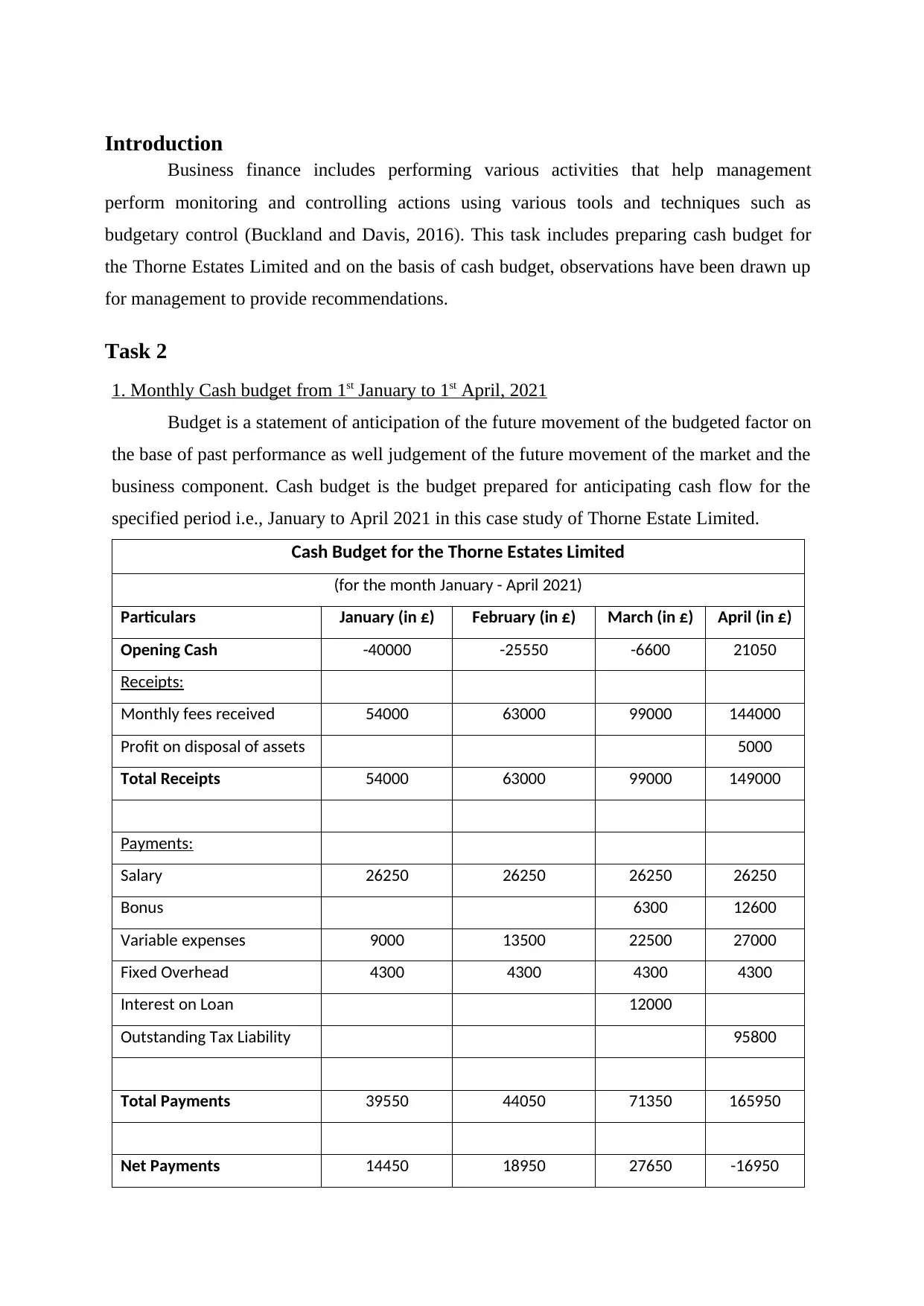
Introduction
Business finance includes performing various activities that help management
perform monitoring and controlling actions using various tools and techniques such as
budgetary control (Buckland and Davis, 2016). This task includes preparing cash budget for
the Thorne Estates Limited and on the basis of cash budget, observations have been drawn up
for management to provide recommendations.
Task 2
1. Monthly Cash budget from 1st January to 1st April, 2021
Budget is a statement of anticipation of the future movement of the budgeted factor on
the base of past performance as well judgement of the future movement of the market and the
business component. Cash budget is the budget prepared for anticipating cash flow for the
specified period i.e., January to April 2021 in this case study of Thorne Estate Limited.
Cash Budget for the Thorne Estates Limited
(for the month January - April 2021)
Particulars January (in £) February (in £) March (in £) April (in £)
Opening Cash -40000 -25550 -6600 21050
Receipts:
Monthly fees received 54000 63000 99000 144000
Profit on disposal of assets 5000
Total Receipts 54000 63000 99000 149000
Payments:
Salary 26250 26250 26250 26250
Bonus 6300 12600
Variable expenses 9000 13500 22500 27000
Fixed Overhead 4300 4300 4300 4300
Interest on Loan 12000
Outstanding Tax Liability 95800
Total Payments 39550 44050 71350 165950
Net Payments 14450 18950 27650 -16950
Business finance includes performing various activities that help management
perform monitoring and controlling actions using various tools and techniques such as
budgetary control (Buckland and Davis, 2016). This task includes preparing cash budget for
the Thorne Estates Limited and on the basis of cash budget, observations have been drawn up
for management to provide recommendations.
Task 2
1. Monthly Cash budget from 1st January to 1st April, 2021
Budget is a statement of anticipation of the future movement of the budgeted factor on
the base of past performance as well judgement of the future movement of the market and the
business component. Cash budget is the budget prepared for anticipating cash flow for the
specified period i.e., January to April 2021 in this case study of Thorne Estate Limited.
Cash Budget for the Thorne Estates Limited
(for the month January - April 2021)
Particulars January (in £) February (in £) March (in £) April (in £)
Opening Cash -40000 -25550 -6600 21050
Receipts:
Monthly fees received 54000 63000 99000 144000
Profit on disposal of assets 5000
Total Receipts 54000 63000 99000 149000
Payments:
Salary 26250 26250 26250 26250
Bonus 6300 12600
Variable expenses 9000 13500 22500 27000
Fixed Overhead 4300 4300 4300 4300
Interest on Loan 12000
Outstanding Tax Liability 95800
Total Payments 39550 44050 71350 165950
Net Payments 14450 18950 27650 -16950
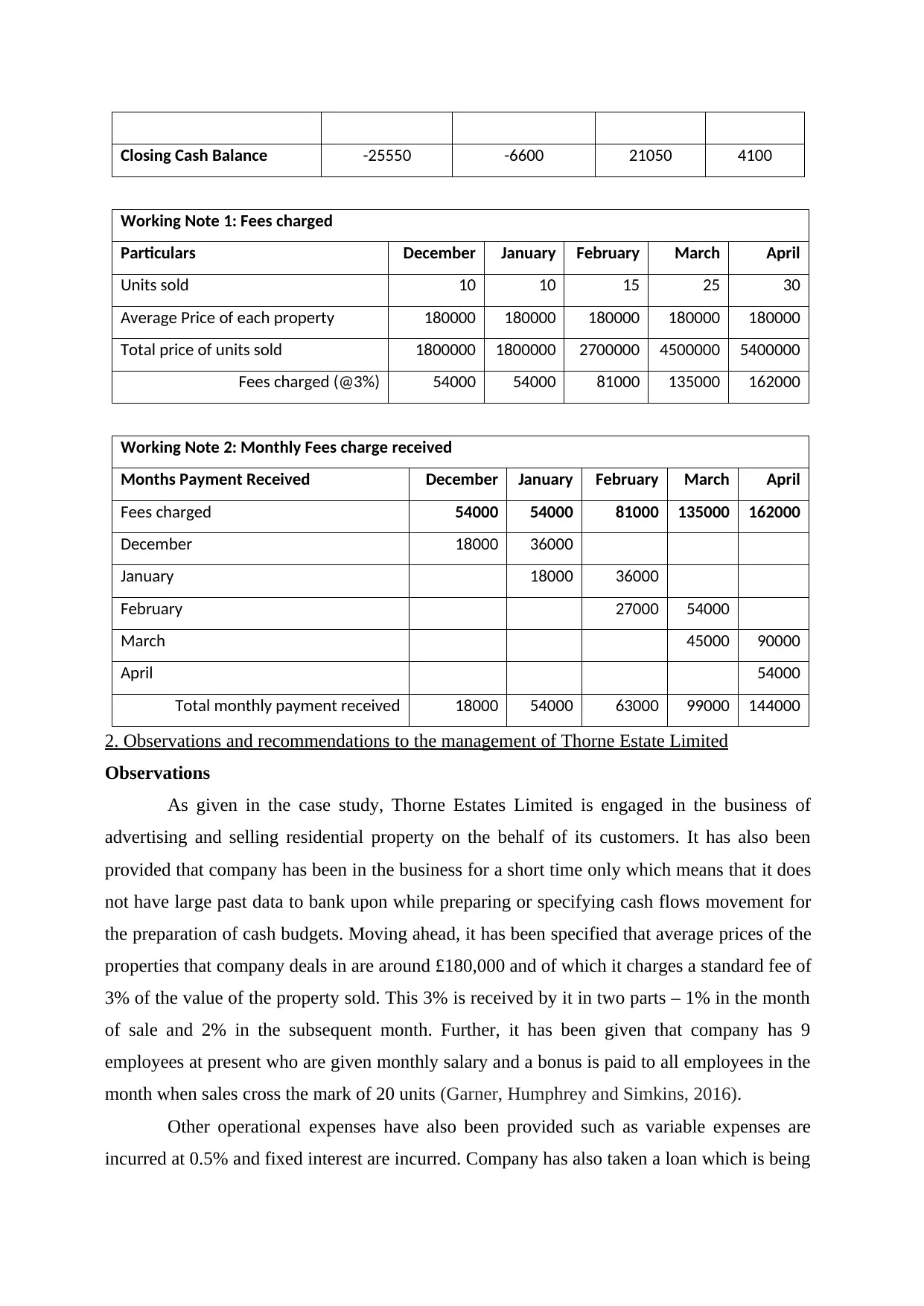
Closing Cash Balance -25550 -6600 21050 4100
Working Note 1: Fees charged
Particulars December January February March April
Units sold 10 10 15 25 30
Average Price of each property 180000 180000 180000 180000 180000
Total price of units sold 1800000 1800000 2700000 4500000 5400000
Fees charged (@3%) 54000 54000 81000 135000 162000
Working Note 2: Monthly Fees charge received
Months Payment Received December January February March April
Fees charged 54000 54000 81000 135000 162000
December 18000 36000
January 18000 36000
February 27000 54000
March 45000 90000
April 54000
Total monthly payment received 18000 54000 63000 99000 144000
2. Observations and recommendations to the management of Thorne Estate Limited
Observations
As given in the case study, Thorne Estates Limited is engaged in the business of
advertising and selling residential property on the behalf of its customers. It has also been
provided that company has been in the business for a short time only which means that it does
not have large past data to bank upon while preparing or specifying cash flows movement for
the preparation of cash budgets. Moving ahead, it has been specified that average prices of the
properties that company deals in are around £180,000 and of which it charges a standard fee of
3% of the value of the property sold. This 3% is received by it in two parts – 1% in the month
of sale and 2% in the subsequent month. Further, it has been given that company has 9
employees at present who are given monthly salary and a bonus is paid to all employees in the
month when sales cross the mark of 20 units (Garner, Humphrey and Simkins, 2016).
Other operational expenses have also been provided such as variable expenses are
incurred at 0.5% and fixed interest are incurred. Company has also taken a loan which is being
Working Note 1: Fees charged
Particulars December January February March April
Units sold 10 10 15 25 30
Average Price of each property 180000 180000 180000 180000 180000
Total price of units sold 1800000 1800000 2700000 4500000 5400000
Fees charged (@3%) 54000 54000 81000 135000 162000
Working Note 2: Monthly Fees charge received
Months Payment Received December January February March April
Fees charged 54000 54000 81000 135000 162000
December 18000 36000
January 18000 36000
February 27000 54000
March 45000 90000
April 54000
Total monthly payment received 18000 54000 63000 99000 144000
2. Observations and recommendations to the management of Thorne Estate Limited
Observations
As given in the case study, Thorne Estates Limited is engaged in the business of
advertising and selling residential property on the behalf of its customers. It has also been
provided that company has been in the business for a short time only which means that it does
not have large past data to bank upon while preparing or specifying cash flows movement for
the preparation of cash budgets. Moving ahead, it has been specified that average prices of the
properties that company deals in are around £180,000 and of which it charges a standard fee of
3% of the value of the property sold. This 3% is received by it in two parts – 1% in the month
of sale and 2% in the subsequent month. Further, it has been given that company has 9
employees at present who are given monthly salary and a bonus is paid to all employees in the
month when sales cross the mark of 20 units (Garner, Humphrey and Simkins, 2016).
Other operational expenses have also been provided such as variable expenses are
incurred at 0.5% and fixed interest are incurred. Company has also taken a loan which is being
⊘ This is a preview!⊘
Do you want full access?
Subscribe today to unlock all pages.

Trusted by 1+ million students worldwide
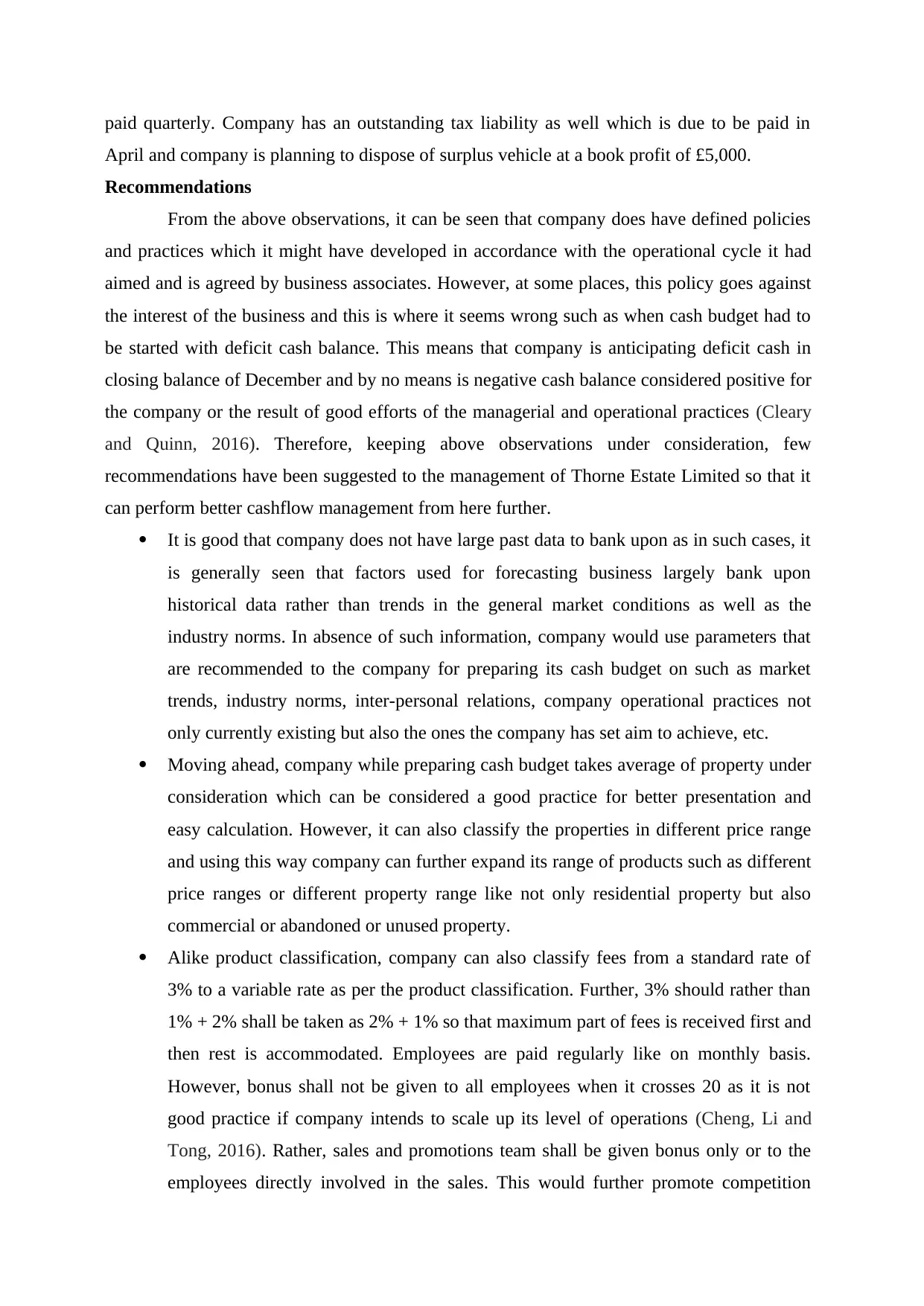
paid quarterly. Company has an outstanding tax liability as well which is due to be paid in
April and company is planning to dispose of surplus vehicle at a book profit of £5,000.
Recommendations
From the above observations, it can be seen that company does have defined policies
and practices which it might have developed in accordance with the operational cycle it had
aimed and is agreed by business associates. However, at some places, this policy goes against
the interest of the business and this is where it seems wrong such as when cash budget had to
be started with deficit cash balance. This means that company is anticipating deficit cash in
closing balance of December and by no means is negative cash balance considered positive for
the company or the result of good efforts of the managerial and operational practices (Cleary
and Quinn, 2016). Therefore, keeping above observations under consideration, few
recommendations have been suggested to the management of Thorne Estate Limited so that it
can perform better cashflow management from here further.
It is good that company does not have large past data to bank upon as in such cases, it
is generally seen that factors used for forecasting business largely bank upon
historical data rather than trends in the general market conditions as well as the
industry norms. In absence of such information, company would use parameters that
are recommended to the company for preparing its cash budget on such as market
trends, industry norms, inter-personal relations, company operational practices not
only currently existing but also the ones the company has set aim to achieve, etc.
Moving ahead, company while preparing cash budget takes average of property under
consideration which can be considered a good practice for better presentation and
easy calculation. However, it can also classify the properties in different price range
and using this way company can further expand its range of products such as different
price ranges or different property range like not only residential property but also
commercial or abandoned or unused property.
Alike product classification, company can also classify fees from a standard rate of
3% to a variable rate as per the product classification. Further, 3% should rather than
1% + 2% shall be taken as 2% + 1% so that maximum part of fees is received first and
then rest is accommodated. Employees are paid regularly like on monthly basis.
However, bonus shall not be given to all employees when it crosses 20 as it is not
good practice if company intends to scale up its level of operations (Cheng, Li and
Tong, 2016). Rather, sales and promotions team shall be given bonus only or to the
employees directly involved in the sales. This would further promote competition
April and company is planning to dispose of surplus vehicle at a book profit of £5,000.
Recommendations
From the above observations, it can be seen that company does have defined policies
and practices which it might have developed in accordance with the operational cycle it had
aimed and is agreed by business associates. However, at some places, this policy goes against
the interest of the business and this is where it seems wrong such as when cash budget had to
be started with deficit cash balance. This means that company is anticipating deficit cash in
closing balance of December and by no means is negative cash balance considered positive for
the company or the result of good efforts of the managerial and operational practices (Cleary
and Quinn, 2016). Therefore, keeping above observations under consideration, few
recommendations have been suggested to the management of Thorne Estate Limited so that it
can perform better cashflow management from here further.
It is good that company does not have large past data to bank upon as in such cases, it
is generally seen that factors used for forecasting business largely bank upon
historical data rather than trends in the general market conditions as well as the
industry norms. In absence of such information, company would use parameters that
are recommended to the company for preparing its cash budget on such as market
trends, industry norms, inter-personal relations, company operational practices not
only currently existing but also the ones the company has set aim to achieve, etc.
Moving ahead, company while preparing cash budget takes average of property under
consideration which can be considered a good practice for better presentation and
easy calculation. However, it can also classify the properties in different price range
and using this way company can further expand its range of products such as different
price ranges or different property range like not only residential property but also
commercial or abandoned or unused property.
Alike product classification, company can also classify fees from a standard rate of
3% to a variable rate as per the product classification. Further, 3% should rather than
1% + 2% shall be taken as 2% + 1% so that maximum part of fees is received first and
then rest is accommodated. Employees are paid regularly like on monthly basis.
However, bonus shall not be given to all employees when it crosses 20 as it is not
good practice if company intends to scale up its level of operations (Cheng, Li and
Tong, 2016). Rather, sales and promotions team shall be given bonus only or to the
employees directly involved in the sales. This would further promote competition
Paraphrase This Document
Need a fresh take? Get an instant paraphrase of this document with our AI Paraphraser
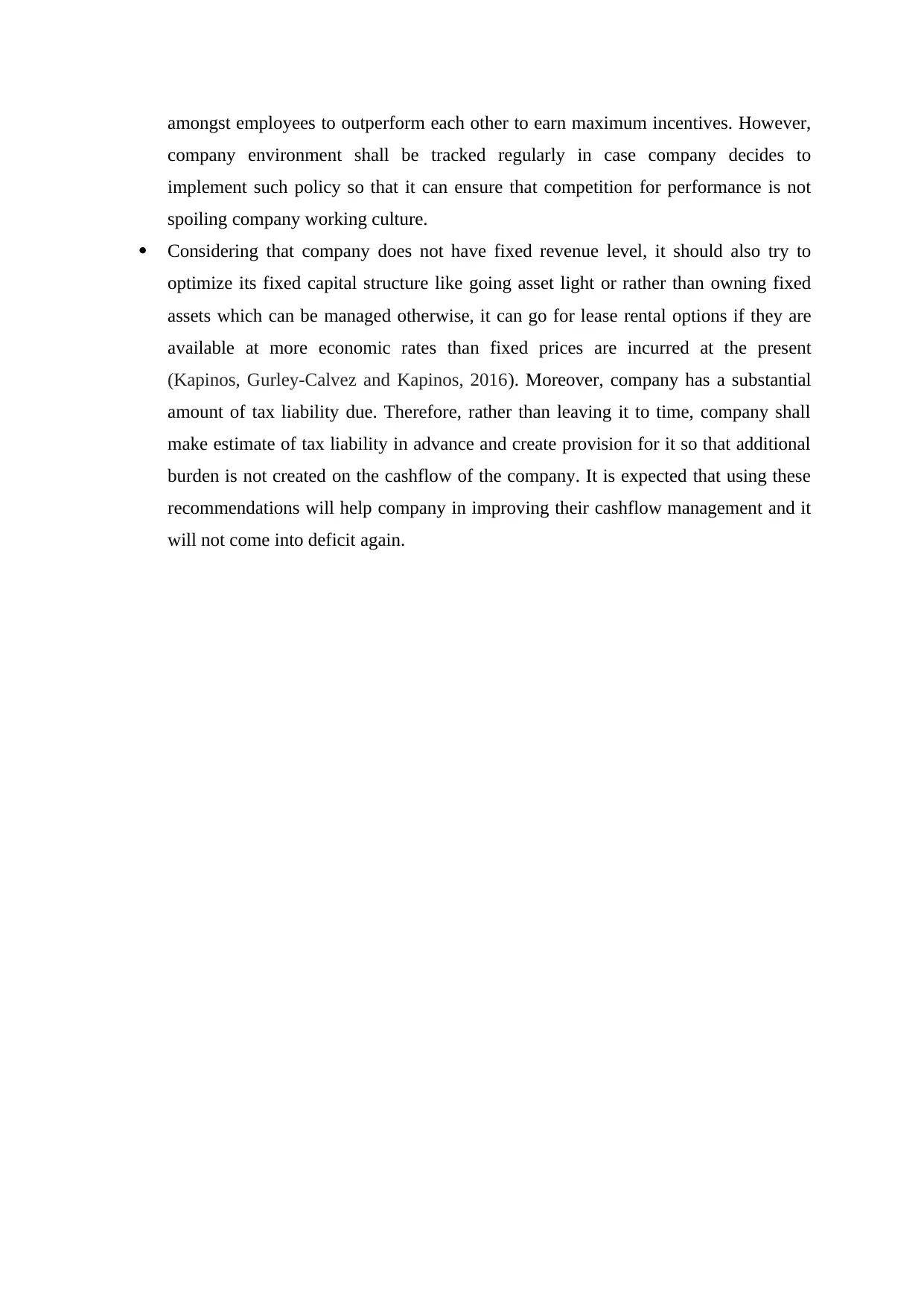
amongst employees to outperform each other to earn maximum incentives. However,
company environment shall be tracked regularly in case company decides to
implement such policy so that it can ensure that competition for performance is not
spoiling company working culture.
Considering that company does not have fixed revenue level, it should also try to
optimize its fixed capital structure like going asset light or rather than owning fixed
assets which can be managed otherwise, it can go for lease rental options if they are
available at more economic rates than fixed prices are incurred at the present
(Kapinos, Gurley-Calvez and Kapinos, 2016). Moreover, company has a substantial
amount of tax liability due. Therefore, rather than leaving it to time, company shall
make estimate of tax liability in advance and create provision for it so that additional
burden is not created on the cashflow of the company. It is expected that using these
recommendations will help company in improving their cashflow management and it
will not come into deficit again.
company environment shall be tracked regularly in case company decides to
implement such policy so that it can ensure that competition for performance is not
spoiling company working culture.
Considering that company does not have fixed revenue level, it should also try to
optimize its fixed capital structure like going asset light or rather than owning fixed
assets which can be managed otherwise, it can go for lease rental options if they are
available at more economic rates than fixed prices are incurred at the present
(Kapinos, Gurley-Calvez and Kapinos, 2016). Moreover, company has a substantial
amount of tax liability due. Therefore, rather than leaving it to time, company shall
make estimate of tax liability in advance and create provision for it so that additional
burden is not created on the cashflow of the company. It is expected that using these
recommendations will help company in improving their cashflow management and it
will not come into deficit again.
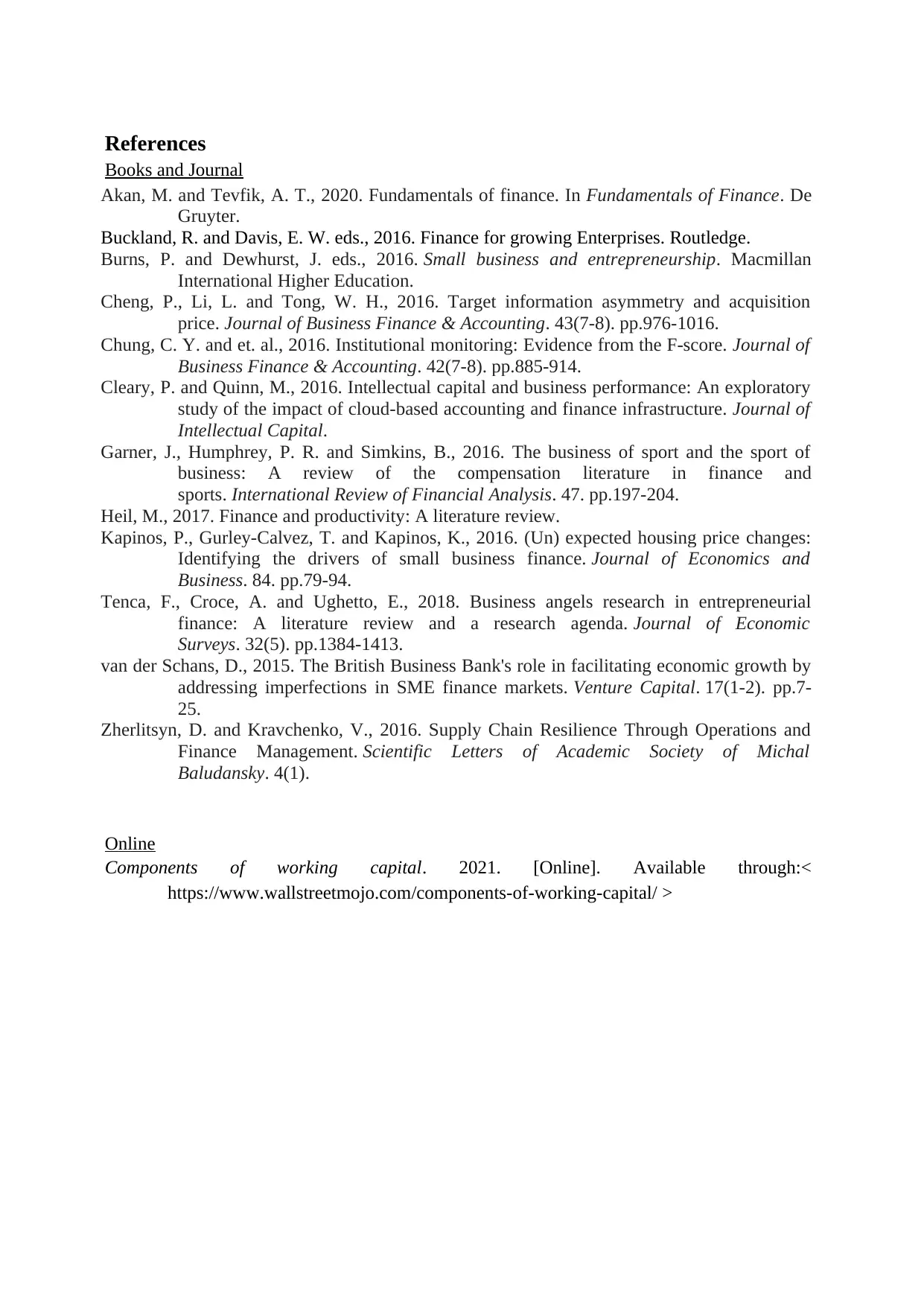
References
Books and Journal
Akan, M. and Tevfik, A. T., 2020. Fundamentals of finance. In Fundamentals of Finance. De
Gruyter.
Buckland, R. and Davis, E. W. eds., 2016. Finance for growing Enterprises. Routledge.
Burns, P. and Dewhurst, J. eds., 2016. Small business and entrepreneurship. Macmillan
International Higher Education.
Cheng, P., Li, L. and Tong, W. H., 2016. Target information asymmetry and acquisition
price. Journal of Business Finance & Accounting. 43(7-8). pp.976-1016.
Chung, C. Y. and et. al., 2016. Institutional monitoring: Evidence from the F‐score. Journal of
Business Finance & Accounting. 42(7-8). pp.885-914.
Cleary, P. and Quinn, M., 2016. Intellectual capital and business performance: An exploratory
study of the impact of cloud-based accounting and finance infrastructure. Journal of
Intellectual Capital.
Garner, J., Humphrey, P. R. and Simkins, B., 2016. The business of sport and the sport of
business: A review of the compensation literature in finance and
sports. International Review of Financial Analysis. 47. pp.197-204.
Heil, M., 2017. Finance and productivity: A literature review.
Kapinos, P., Gurley-Calvez, T. and Kapinos, K., 2016. (Un) expected housing price changes:
Identifying the drivers of small business finance. Journal of Economics and
Business. 84. pp.79-94.
Tenca, F., Croce, A. and Ughetto, E., 2018. Business angels research in entrepreneurial
finance: A literature review and a research agenda. Journal of Economic
Surveys. 32(5). pp.1384-1413.
van der Schans, D., 2015. The British Business Bank's role in facilitating economic growth by
addressing imperfections in SME finance markets. Venture Capital. 17(1-2). pp.7-
25.
Zherlitsyn, D. and Kravchenko, V., 2016. Supply Chain Resilience Through Operations and
Finance Management. Scientific Letters of Academic Society of Michal
Baludansky. 4(1).
Online
Components of working capital. 2021. [Online]. Available through:<
https://www.wallstreetmojo.com/components-of-working-capital/ >
Books and Journal
Akan, M. and Tevfik, A. T., 2020. Fundamentals of finance. In Fundamentals of Finance. De
Gruyter.
Buckland, R. and Davis, E. W. eds., 2016. Finance for growing Enterprises. Routledge.
Burns, P. and Dewhurst, J. eds., 2016. Small business and entrepreneurship. Macmillan
International Higher Education.
Cheng, P., Li, L. and Tong, W. H., 2016. Target information asymmetry and acquisition
price. Journal of Business Finance & Accounting. 43(7-8). pp.976-1016.
Chung, C. Y. and et. al., 2016. Institutional monitoring: Evidence from the F‐score. Journal of
Business Finance & Accounting. 42(7-8). pp.885-914.
Cleary, P. and Quinn, M., 2016. Intellectual capital and business performance: An exploratory
study of the impact of cloud-based accounting and finance infrastructure. Journal of
Intellectual Capital.
Garner, J., Humphrey, P. R. and Simkins, B., 2016. The business of sport and the sport of
business: A review of the compensation literature in finance and
sports. International Review of Financial Analysis. 47. pp.197-204.
Heil, M., 2017. Finance and productivity: A literature review.
Kapinos, P., Gurley-Calvez, T. and Kapinos, K., 2016. (Un) expected housing price changes:
Identifying the drivers of small business finance. Journal of Economics and
Business. 84. pp.79-94.
Tenca, F., Croce, A. and Ughetto, E., 2018. Business angels research in entrepreneurial
finance: A literature review and a research agenda. Journal of Economic
Surveys. 32(5). pp.1384-1413.
van der Schans, D., 2015. The British Business Bank's role in facilitating economic growth by
addressing imperfections in SME finance markets. Venture Capital. 17(1-2). pp.7-
25.
Zherlitsyn, D. and Kravchenko, V., 2016. Supply Chain Resilience Through Operations and
Finance Management. Scientific Letters of Academic Society of Michal
Baludansky. 4(1).
Online
Components of working capital. 2021. [Online]. Available through:<
https://www.wallstreetmojo.com/components-of-working-capital/ >
⊘ This is a preview!⊘
Do you want full access?
Subscribe today to unlock all pages.

Trusted by 1+ million students worldwide
1 out of 12
Related Documents
Your All-in-One AI-Powered Toolkit for Academic Success.
+13062052269
info@desklib.com
Available 24*7 on WhatsApp / Email
![[object Object]](/_next/static/media/star-bottom.7253800d.svg)
Unlock your academic potential
Copyright © 2020–2025 A2Z Services. All Rights Reserved. Developed and managed by ZUCOL.




